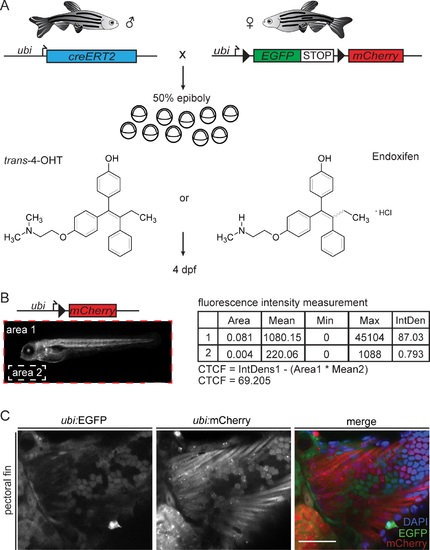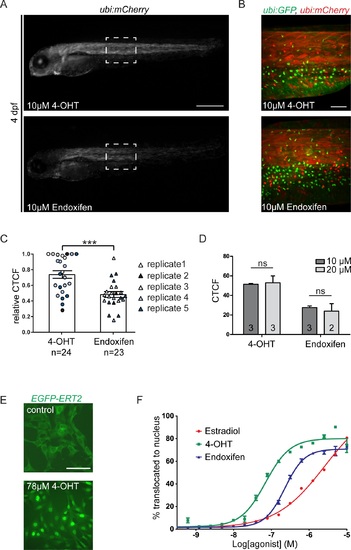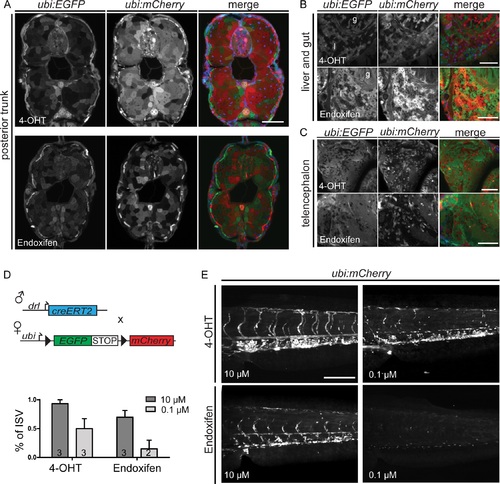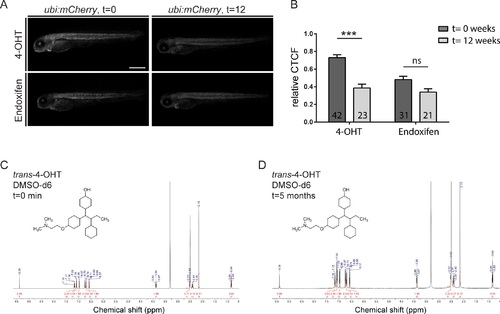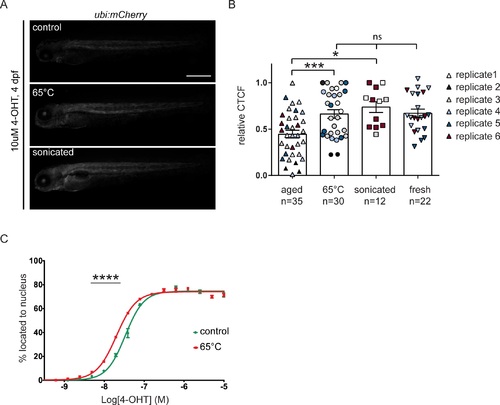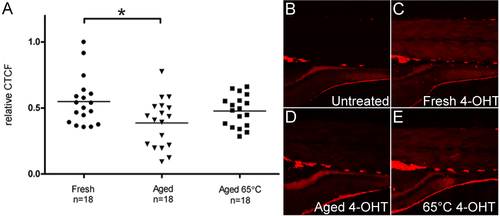- Title
-
In Vivo Performance and Properties of Tamoxifen Metabolites for CreERT2 Control
- Authors
- Felker, A., Nieuwenhuize, S., Dolbois, A., Blazkova, K., Hess, C., Low, L.W., Burger, S., Samson, N., Carney, T.J., Bartunek, P., Nevado, C., Mosimann, C.
- Source
- Full text @ PLoS One
|
Experimental workflow to assess CreERT2 induction potency. Offspring of male ubi:creERT2 to female ubi:Switch crosses were induced with either trans-4-OHT or Endoxifen consistently at 50% epiboly. Imaging was performed at 4 dpf. Double-positive embryos were placed lateral (anterior to the left) and an image was taken of the whole embryo applying the same settings. Fluorescence was quantified using an automated Macro in ImageJ. Scale bar 500 µm. (C) To address a potential tissue bias due to possibly restricted drug penetration and recombination, we performed transverse vibratome sections of 4 dpf ubi:creERT2;ubi:Switch embryos induced under the same conditions as the embryos used for epi-fluorescence measurements (scale bar 50 µm). The depicted example images show switching in pectoral fin tissue after 4-OHT induction; merged: EGFP, mCherry and DAPI. |
|
Endoxifen potently induces CreERT2 activity in zebrafish and ERT2 reporters in cell culture. (A) Fluorescence intensity was quantified in ubi:creERT2;ubi:Switch embryos induced with freshly dissolved trans-4-OHT and Endoxifen (both 10 µM) as a measurement for drug potency (scale bar 500 µm). (A, B) Both compounds efficiently confer CreERT2 mediated recombination as seen in the whole embryo and maximum intensity projections of the trunk imaged with the Zeiss Z.1 lightsheet microscope. (A) scale bar 500 µm, (B) 100 µm. Representative images are shown for each condition. (C) Quantifications of the fluorescence show that Endoxifen induces CreERT2 activity with approximately half the potency (two-tailed, unpaired t-test, p = 0.0001). (D) Switching experiments were done at saturated conditions; increasing the concentration does not increase potency neither for trans-4-OHT nor Endoxifen (two-way ANOVA, column p-value 0.8232). (E) EGFP-ERT2 cells were treated with different concentrations of E2, trans-4-OHT, and Endoxifen. Cells were imaged after 20 hours post treatment using High-content imaging system Operetta (Perkin Elmer). Representative images are shown (scale bar 100 µm). (F) Data from multiple fields were analyzed using Columbus software (Perkin Elmer) and the percentage of translocation was plotted using GraphPad Prism software. Endoxifen acts with slightly lower potency than trans-4-OHT, but both compounds are more potent than the native ligand E2. |
|
Endoxifen confers CreERT2 mediated recombination at a lower potency in tissue specific lineage tracing experiment. (A-C) Transverse vibratome sections of ubi:creERT2;ubi:Switch at 4 dpf were performed to control for tissue bias in trans-4-OHT- versus Endoxifen-induced recombination. (A) Sections of posterior trunk (trans-4-OHT n = 13; Endoxifen n = 10), (B) anterior liver (l) and gut (g) (trans-4-OHT n = 7; Endoxifen n = 3), and (C) telencephalon (trans 4-OHT n = 7; Endoxifen n = 3) show similar switching efficiencies among tissue sections between the two compound treatments. Representative images are shown for each condition. Merged: EGFP, mCherry, and DAPI. (D) To compare trans-4-OHT and Endoxifen potency in a tissue-specific lineage tracing experiment, drl:creERT2 transgenics were crossed to ubi:Switch. (D, E) trans-4-OHT induced CreERT2 mediated recombination more potently at saturated concentrations (10 µM) and non-saturated conditions (0.1 µM) compared to Endoxifen. For quantifications shown in D, switched intersomitic vessels (ISV) in trans-4-OHT or Endoxifen treated drl:creERT2;ubi:Switch were imaged with the Zeiss lightsheet Z.1 and counted in the maximum intensity projection (scale bars 200 µm). In embryos treated with 10 µM trans-4-OHT, all ISVs in the analyzed part of the trunk are mCherry positive with very few parts of individual ISVs unlabeled. Reducing the concentration to 0.1 µM confers sub-optimal switching for clonal analysis. Endoxifen shows lower potency with fewer mCherry positive ISVs. Lowering Endoxifen concentration to 0.1 µM fails to induce efficient CreERT2 activation. |
|
In contrast to Endoxifen, trans-4-OHT loses its potency over time independently from isomerization. (A) Switching efficiency was quantified comparing fresh and 12 weeks old trans-4-OHT and Endoxifen (scale bar 500 µm). (B) mCherry intensity in embryos treated with 12 weeks old trans-4-OHT is approximately half compared to intensities measured in embryos induced with fresh trans-4-OHT (two-tailed, unpaired t-test, p<0.0001). The potency of Endoxifen does not change significantly throughout the same time period (two-tailed, unpaired t-test, p = 4598). (C) The 1H NMR spectrum of trans-4-OHT freshly dissolved in DMSO-d6 reveals the presence of ≥98% of the trans isomer. (D) After 5 months storage in DMSO-d6, no appreciable change in isomer composition can be detected by 1H NMR. |
|
Heating or sonication restores lost trans-4-OHT potency. (A) mCherry intensity was quantified in embryos induced with >12 weeks old trans-4-OHT that was heated at 65°C or sonicated for 10 min prior to addition to E3 (scale bar 500 µm). (B) Heating or sonicating restores aged trans-4-OHT activity compared to both non-heated/non-sonicated compound to levels of the fresh compound (two-tailed, unpaired t-test, aged vs heated p = 0.0008, aged vs sonicated p = 0.0319, heated vs fresh p = 0.9029, sonicated vs fresh p = 0.1684). (C) EGFP-ERT2 cells were treated with different concentrations of control or heated (10 min at 65°C) aged trans-4-OHT. Images were taken 20 h post treatment and analyzed using Columbus software. Percentage of translocation was plotted using GraphPad Prism software. Heating moderately improves trans-4-OHT potency to induce translocation of EGFP-ERT2 to the nucleus (two-way ANOVA, p<0.0001). |
|
Relative CTCF of embryos treated with trans-4-OHT stored at 5 mM. (A) Relative CTCF of ubi:creERT2; ubi:Switch embryos treated with fresh trans-4-OHT compared to treatment with aged trans-4-OHT stored in 5 mM Ethanol, either unheated or heated to 65°C. To compare the activity between fresh and aged trans-4-OHT, we used a one-way ANOVA (two-tailed, unpaired t-test, aged vs heated p = 0.0126). (B-E) Lateral confocal images of mCherry expression in the anterior trunk of larvae untreated (B) or treated with fresh trans-4-OHT (C), aged trans-4-OHT dissolved in 5 mM Ethanol and stored for two years (D) and aged trans-4-OHT dissolved in 5 mM Ethanol and stored for two years and then heated at 65°C. |

